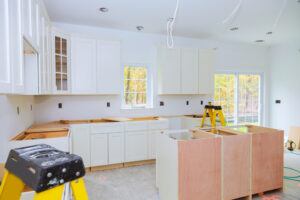Basic Steps of Kitchen Remodeling
Remodeling your kitchen not only improves your home’s value but also allows the space to function in a way that works better for you.
- Kitchen renovations can be difficult and are best left to professionals.
- Planning out the process carefully helps you get the results you want.
- Every renovation differs, but there are several basic steps of kitchen remodeling.
Tackling a renovation project in your home is always a big undertaking, but few projects are more rewarding than a kitchen renovation. For individuals and families alike, the kitchen serves as the hub of the home. A kitchen with a good layout makes cooking, eating, and entertaining easier and much more enjoyable. If your current kitchen isn’t working for you, either functionally or aesthetically, finding a kitchen remodeling contractor who can help you redesign your space is the first step toward creating the kitchen of your dreams.
The Planning Process
Renovating a kitchen involves multiple steps and can often take a significant amount of time. Choosing an experienced contractor can help you realize your vision as quickly as possible, minimizing your kitchen downtime and providing the high-quality results you deserve.
Think of the Big Picture
As the planning process begins, everything should begin by mapping out the big picture for your renovation. Determine what elements of your current kitchen no longer work and your primary goals for a finished product. During big picture planning, you can visualize on as grand of a scale as you want because your ideas can always be scaled down to a more realistic plan later. It also helps to develop an idea of what you need to keep.
Determine the Necessities
With any home renovation, your plans likely include both necessary changes and desired changes. Once you have a big idea of how you want your kitchen to function, determine which changes are necessities and which ones are extras you would like included if possible. When scaling down later, you can use your wants list to trim down items if necessary.
Rough Out a Design
If you have decided which design features are non-negotiable to your overall big picture plan and which ones are more flexible, it’s time to roughly design what your ideal space includes. This rough picture will likely not closely resemble the final product, but it can give your contractor an idea about what you have in mind.
Shop For a Contractor
Using your broadly sketched design, list of necessities, and general budget, the next step is to lock down a kitchen remodeling contractor. Some homeowners tackle smaller renovations as a do-it-yourself project, which is possible if you have completed the changes you plan to make or are only making small edits to the space. In general, renovating a kitchen involves activities that are beyond the scope of the average DIYer, such as plumbing, wiring, countertops, sinks, and layout changes. It’s important to find a contractor that is reputable, experienced, and attentive during your initial consultation.

The Kitchen Renovation Process
The kitchen remodeling planning process is only the first part of your renovation story. After you have nailed down a contractor who is ready and willing to work with your budget and non-negotiable renovation needs, the real renovation process begins.
Detailed Design and Materials
Before any physical work begins on your property, the contractor creates a detailed plan and timeline to perform your work. The plan should include a visual representation of the intended results and a detailed, budgeted list of materials and labor. The designer affiliated with your home renovation company provides options for the materials you can use in your project, or you can provide your own ideas. Materials selection could involve a visit to a design showroom or different vendors.
Prepare For Construction
The first day your construction team arrives on the job can be as simple as a measurement session or as complicated as a full kitchen demolition. If your old kitchen is scheduled for demolition, there are ways to prepare so you can make the burden of being without a kitchen for an extended time easier. Some people choose to set up a temporary kitchenette in a different area, while others plan out their meals in other ways.
As with all construction projects, prepare for your home to be a bit messy for a while. If possible, close the kitchen off to other areas of the home and provide a pathway for demolition and construction personnel to use. Your crew should protect areas in the kitchen that need to avoid damage.
Building and Installation
What seems like one of the longest parts of the process can often be accomplished in just a few days by an experienced team. Depending on the scope and size of your project, the building and installation process could include installing new floors, adding in cabinetry and storage, creating a kitchen island, and adding in countertops. Drywall on the walls and ceilings are also finished up at this point. Although the fixtures and faucets come later, the rough-in for electrical and plumbing are also completed where necessary before those areas are closed off by new structures.
Wiring and Plumbing
Roughing in the wiring and plumbing takes place in an earlier stage if new components are necessary. Still, if the wiring and plumbing were already present and new lighting and appliances are the main changes, this can be completed after the building and installation processes are finished. This is the time when appliances are delivered and hooked up with the current connections, new light fixtures are connected and tested, and your new faucets are installed.
Finishing Touches
Once your big-ticket items are installed and your new kitchen is functional, your team is ready to complete the finishing touches. If this was not completed during the building and installation state, this could mean installing a backsplash, painting the walls, adding hardware to the cabinets, hanging artwork, bringing in furniture, and other small details that give your space a finished look. At the final stage, the contractor also creates a punch list for any items that need to be cleaned up, such as dings, scratches, and other imperfections. These blemishes are corrected before the final inspection.

Final Inspection and Project Completion
Before your kitchen renovation is considered complete, your contractor makes sure everything on the punch list has been corrected, everything is functioning correctly, and you are completely satisfied with the results. Any final inspections that are required by the local building code must be complete, and the permits must be finalized before the contractor signs off on the project. If you find anything that isn’t to your satisfaction, including the clean-up job, make sure it is remedied before you put your seal of approval on the project.
Plan Your Kitchen Renovation
Kitchen renovations can be costly and difficult, but it is well worth it if you put your trust in an experienced contractor. As one of the most frequently used areas of the home, a well-functioning and attractive kitchen can raise your house value and provide years of service. To schedule a consultation for your next home improvement project, contact JSB Home Solutions today.
![]()
Featured Image: ungvar/Shutterstock
Next Steps!
Schedule a free consultation to see how JSB Home Solutions can help transform your home!

